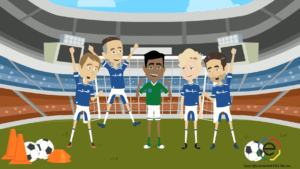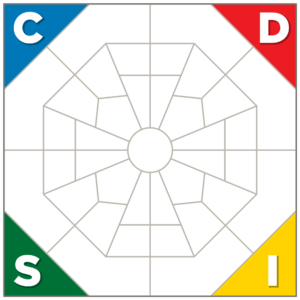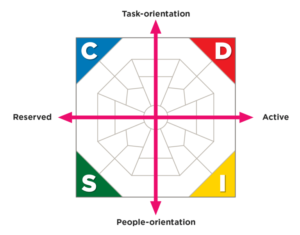How are DISC styles different? A person’s DISC profile does not limit what he/she can accomplish or how successful he/she can be. It simply predicts how he/she tends and prefers to do things. Here’s an example of how each of the 4 DISC style employees might respond when they receive a call from their boss.
Archives: Videos
YouTube video posts
Improving your understanding of DISC C-style
C-styles are Task-Oriented and Reserved. The C-style training video will teach you how C-styles communicate, act under pressure, decide, succeed, and much more!
C-style
C-styles are the most analytical of the four DISC styles. C’s are perfectionists, detail-oriented, and focused on facts, information and proofs. A C-Style is comfortable working alone and is the most reserved of the four DISC styles. They are logical, systematic, cautious and methodical. They focus on working with the existing circumstances to ensure high quality of product or service. C-styles’ biggest fear is criticism of their work. A C-styles motto is: “If we do not have time to do it right, do we have time to do it over again?”
How C-Styles communicate

C-styles prefer written communication and to include facts and details. They tend not to share about their own opinions unless they know the subject matter well. Their favorite question is “Why?” such as in “Why does it work this way?” and “Why is this step necessary in the process?”
How C-Styles Decide

C-styles are focused on making correct decisions and avoiding mistakes. As a result, their decision-making is exact and accurate. However, this can slow down their decision-making. C-styles can over-analyze issues and require a lot of information.
How C-Styles act under pressure

Under pressure, C-styles can be overly critical of others. They have a tendency to be so focused on the details that they often find small mistakes and errors. Others may see their attention to detail and correctness as nit-picky, but C-styles expect even more of themselves. C-styles are very self-critical. Under pressure, C-styles continue to gather more information to guide their decision and actions, further slowing down progress.
How C-Styles succeed

C-styles succeed by focusing their efforts on the task at hand. They are not easily distracted and are focused on producing high quality work. C-styles approach tasks and projects well prepared. C-styles become very knowledgeable and skilled, even experts in their field.
Other DISC styles
Watch the other DISC training videos to understand all four DISC styles and DISC assessments!
Improving your understanding of DISC S-style
S-styles are People-Oriented and Reserved. The S-style training video will teach you how S-styles communicate, act under pressure, decide, succeed, and much more!
S-style
An S-style is steady, calm, sincere and laid back. While they do like interaction with other people, they’re more reserved and less animated than I-styles. They are eager to help and support others. They enjoy working in a team environment and often will loyally defend their own group or team. Fairness and justice are very important to S-styles. They do not like to disappoint others or let them down. Since S-styles prefer stability and security, they tend to resist change and may need support with it. Their biggest fear is loss of stability. Their motto is: “If it’s not broken, let’s not fix it.”
How S-Styles communicate

S-styles’ communication is often one directional – they listen. They are polite and answer when asked. S-styles are most comfortable communicating in one-to-one situations. They speak calmly, are good at building trust, and are patient listeners. Their favorite question is “How?” such as “How are we going to do this?” and “How does this impact us?”
How S-Styles Decide

S-styles are prone to be cautious and slower in their decision-making. This is because they consider the impact of their decisions on others and want everyone to get along. S-styles commonly double-check their decisions and often talk them over with someone they trust before making the final decision. They look for support in precedents and information to ensure they make the best decision.
How S-Styles act under pressure

Since they have a tendency to be overly accommodating and polite, under pressure S-styles can become too willing to help and give in to the decisions of others. They frequently say “yes” too easily by putting the needs of others’ ahead of their own. S-styles can also stubbornly hold on to the status quo to protect their sense of security. At times, they overestimate the amount of work involved.
How S-Styles succeed

S-styles succeed by being very persistent and maintaining a long-term perspective. While they are sometimes slower to initiate action, once they do, they are unstoppable. They get things done and ensure tasks are completed well. S-styles execute reliably and consistently.
Other DISC styles
Watch the other DISC training videos to understand all four DISC styles and DISC assessments!
Improving your understanding of DISC I-style
I-styles are People-Oriented and Active. The I-style training video will teach you how I-styles communicate, act under pressure, decide, succeed, and much more!
I-style
I-styles are outgoing, energetic, social, and talkative. An I-style enjoys being the center of attention and like interacting with others or meeting new people. I-styles do not like to focus on details or spend a lot of time alone. Others tend to see I-styles as very friendly, enthusiastic and animated. I’s are optimistic, positive and good at influencing others. Social acceptance is very important for I-styles. I-styles fear social rejection. An I-styles motto is: “I am a nice person! Everyone should like me!”
How I-Styles communicate

I-styles communicate in a way that inspires and promotes their messages. I’s talk a lot, but not about details. I-styles avoid unpleasant subjects and are not always direct. An I-styles favorite question is “Who?” such as: “Who is going to be at the meeting?” and “Who’s in this with me?”
How I-Styles Decide

I-styles decision-making is relatively fast. They are not interested in a lot of detail and supporting information and decisions are often based on intuition and emotions. An I-style keeps others in mind when making decisions and prefer to make “popular” and favorable choices. I-styles are optimistic about the outcomes of their decisions.
How I-Styles act under pressure

Under pressure, I-styles tend to appear disorganized because they focus so much on people and being accepted that they overlook details and tasks. I’s are overly talkative and emotional. An I-style over-promises because they are so optimistic and eager to be liked. Others may perceive I-styles as somewhat careless and impulsive.
How I-Styles succeed

I-styles are successful through their positive, energetic and enthusiastic behavior. An I-style adds openness, generates discussion and new ideas to move forward. I’s connect people and create an enjoyable and positive atmosphere. I-styles get others involved and excited to move toward goals.
Other DISC styles
Watch the other DISC training videos to understand all four DISC styles and DISC assessments!
Improving your understanding of DISC D-style
D-styles are Task-Oriented and Active. The D-style training video will teach you how D-styles communicate, act under pressure, decide, succeed, and much more!
D-style
D-styles are the most forceful and assertive of the four DISC styles. D-styles tend to be direct, results-oriented, competitive and strong-willed. They prefer to move fast, take risks and get things done immediately. They like change and challenges and are multi-taskers. D-styles want to create change; routine is boring to them. They want to be in charge and have the power and control. The D-style motto is: “I did it my way”. One of their biggest fears is to lose control.
How D-Styles communicate

D-styles often communicate in one direction – they talk and expect others to listen. At times they express their own opinions as facts needing no further discussion or input. They may be blunt and challenge others. D-styles are impatient listeners and have a tendency to interrupt. Their favorite question is “What?” such as “What is the bottom line?” and “What’s in it for me?”
How D-Styles Decide

D-styles want to make independent decisions and make them quickly. Since they don’t need a lot of information to swiftly decide and are comfortable taking risks, they’re more likely to make wrong decisions. However, D-styles get over their mistakes quickly and move on by keeping the big picture in mind.
How D-Styles act under pressure

Under pressure they can show a lack of concern for others because they are focusing on the tasks. As a result, others may perceive D-styles as being too aggressive, blunt and even rude. At times, D-styles can also be impatient and overbearing. They’re often not good listeners and prone to making quick decisions. D-styles have a tendency to overlook how their actions and behaviors affect others.
How D-Styles succeed

D-Styles succeed by being decisive, taking risks and focusing on the big picture, results and goals. They are quick to take action, venture into risky and new situations, keep others moving forward and are not hesitant to communicate their own opinions.
Other DISC styles
Watch the other DISC training videos to understand all four DISC styles and DISC assessments!
DISC Training videos enhance learning
There are countless ways for individuals to learn. Some people enjoy reading. Others like to watch videos or listen to an audio recording. Everyone learns differently. Our training videos are the perfect tools to make training effective and fun!
Our training videos will help you understand DISC
Training others to understand DISC and learning DISC yourself is now easier due to our series of DISC training videos. These training videos will help you understand the four DISC styles and the importance of DISC assessments. You can now learn the way you want to through the many methods we have provided.
Why use Extended DISC® Assessments?
Your personal and professional success in life is largely determined by how well you interact with other people. You have probably noticed it is very easy to get along with certain people. You almost instantly and effortlessly understand the other person because communication just flows.
With most people communication takes more effort. It is sometimes hard to understand where the other person is coming from, what they really want, and what their intentions are. Meanwhile, the other person may experience the same uncomfortable feeling. The outcomes of the interaction are not what you want. You may lose a sale, frustrate a customer, de-motivate an employee, or anger a friend. You are likely to feel disappointed, frustrated and even tired. It takes energy, effort and concentration. Still, the results are not what you hoped they would be.
Extended DISC® provides a model to successful interactions:

With Extended DISC® you will learn the four DISC Styles, who you are and how others perceive you by creating a more confident self-awareness, how to read other people and better understand them, and how to modify your behavior to become even more successful!
Extended DISC® is based on the most widely used and accepted model of human behavior. The power of this model is that it is easy to learn, understand, and use because it identifies only four behavioral styles of individuals: D-Style, I-Style, S-Style, and C-Style. People can be divided in four main styles by identifying if they are more: People- or Task-oriented, and Reserved or Active. Please see the model below.

As you learn about the four DISC Styles, please keep in mind that none of the styles are better or worse, and that all styles have strengths and development areas-they just happen to be different. Our style does not limit what we can accomplish or how successful we can be-it simply predicts how we tend to do things. We can find all of the four styles represented by very successful people, however, the most successful people know who they are and they modify their style appropriately with different styles of people and in different situations.